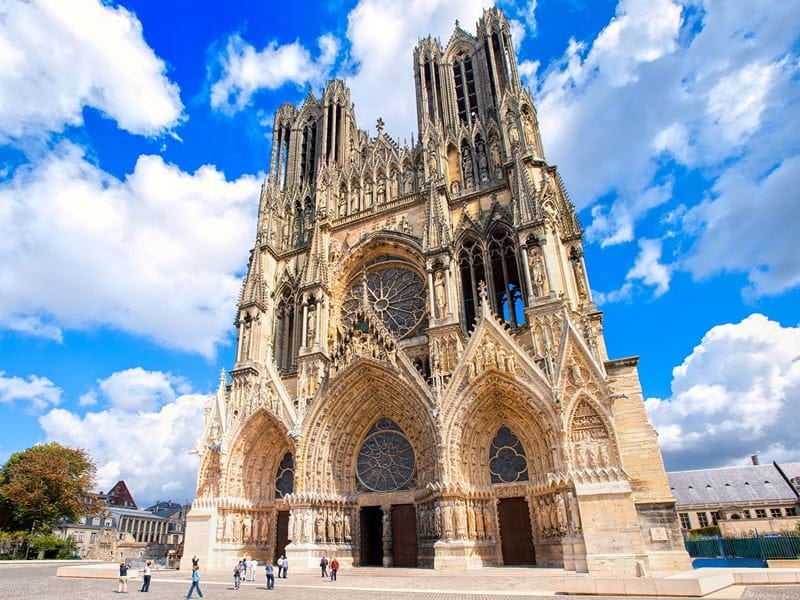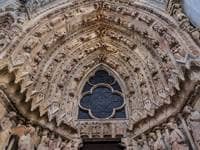
- Trending:
- Seasonal Holidays
- |
- Faith and Mental Health
- |
- Forgiveness
- |
- Advent
- |
- Resurrection
- |
- Gratitude
The 100 Most Holy Places On Earth
Cathédrale Notre-Dame de Reims





Associated Faiths:
Roman Catholicism
Also frequented by Christians of other High and Low-Church traditions.
Accessibility:
Open to visitors.
Annual visitors: 1,500,000
History
The Reims’ Cathedral of Notre-Dame is one of more than 100 French churches bearing the name of “Our Lady,” referential to the Virgin Mary. (Many Westerners erroneously confuse the various French cathedrals bearing the Virgin’s name, both because of their singular namesake, but also because of their architectural similarities.) Notre-Dame de Reims may be most famous for the fact that it has been the traditional location in which the various kings of France were coronated (much like Westminster Abbey for the British).
Though the history of the cathedral is lacking some details, prior to the 5th century, the site was the location of a Gallo-Roman Bathhouse. The first Christian church built on the site is believed to have been constructed in the 5th century—under the direction and inspiration of Bishop Nicasius (a saint in both the Roman Catholic and Eastern Orthodox traditions). It was in the same original Reims Cathedral that Clovis (king of the Franks) converted to Christianity (in the 6th century) and received the sacrament of baptism. Clovis was the first Christian Frankish king.
The original 5th century cathedral was replaced, beginning in the early 9th century—simply because of the inadequate size of the original. Part way through the construction of the new cathedral, it too was deemed too small, and plans were changed—expanding its size significantly in the 10th century. That second cathedral was destroyed by fire in 1210 AD. Constructed after the style of High Gothic architecture, the current Cathédrale Notre-Dame de Reims was erected starting in that same century but was not completed until the mid-14th century. Although it survived the French Revolution with only minor damage, the first world war was not so kind to it. During WWI, the cathedral (then a possession of the state, not the Church) was made into a military hospital. The building sustained significant damage during the war because of shelling in September of 1914. The damages sustained were repaired between 1919-1938.
Because of a 1905 French law regarding the separation of Church and State, the Roman Catholic cathedral at Remis is actually not owned by the Catholic Church. While built and originally a property of the Church, as of 1905, it has been owned by the French state. Legally considered a French tourist attraction, the state has an agreement with the Roman Catholic Church, granting that institution exclusive rights to use the building. The state, however, pays for any repairs and upkeep of the edifice.
Religious Significance
Because thirty-three French sovereigns were coronated in one iteration or another of the Cathédrale Notre-Dame de Reims, there is a sense in which this holy house—now owned by the State of France—is “sacred space” for Church and State. For the Church, it is as any cathedral or sacred space. It is dedicated to the glory and worship of God. For the State, however, the Cathedral represents the divine mandate given to the Frankish monarchs. Like royalty in any nation—particularly those of the past—there was a since that Kings and Queens were selected by God, and royal families were “royal” because of their divine mandate. Consequently, while that chapter in France’s history as closed (there no longer being monarchs and no longer a kingdom, but now a republic), nonetheless, France’s past belief in a divine mandate of their monarchs is symbolized and even sacralized by the “sacred space” we called “Reim’s Cathedral.” As evidence of its sacrality to the State, at the end of WWI, there was discussion of leaving the bombed-out building in its destroyed condition—as a monument to those who fell victim of the war and to the fact that France survived that conflict. While that proposal was rejected, and the cathedral was rebuilt, this proposal shows how the State-owned Cathedral plays a role in the psyche of the citizens of France, as well as that of its practitioners of Catholicism.
Like any church, basilica, or cathedral, Notre-Dame de Reims is “sacred space” because it is not just a “house of worship,” but also a “house of sacraments.” Salvific sacraments have been at the heart of the Church for two millennia. And while some contemporary Roman Catholics may question (in the post-Vatican II era) if they are indeed “salvific,” the Church continues to suggest that they are central to the faith and life of the Church and its people. Thus, any edifice in which those holy sacraments are administered constitutes “sacred space”—simply by virtue of the sacraments and the power which they possess and covey. And because the chief sacrament of the Church—the Eucharist or Sacrament of the Lord’s Supper—has as its core the doctrine of transubstantiation, entering into Reim’s Cathedral is entering into the presence of Christ.
Finally, while it is not uncommon to name Catholic churches after the Virgin Mary, the naming of Reims’ Cathedral has some history tied to it. The original 5th century Cathedral was being constructed just prior to the Council of Ephesus (AD 431), which took up the issue as to whether Mary was simply “Christokos” (the “Christ-bearer”) or “Theotokos” (“God-bearer”). The Council condemned Nestorius, who propagated the false doctrine of Mary as “Christokos,” and declared her as the “Theotokos.” Anticipating the Council and the debate, the cathedral was preemptively named “Notre-Dame” (or the Cathedral of “Our Lady”) evidencing what position the Bishop of Reims held prior to the council.
Like so many other cathedrals built during that era, the Cathédrale Notre-Dame de Reims is an inspiring piece of architecture that forces one’s eyes and heart heavenward. Its name honors the incarnation and the Mother of the Son of God. Its sacraments connect the worshiper with the divine. And its innately sacred space offers a home for the very rites that allow the faith-filled Christian to lay hold on the grace vouchsafed through those holy ordinances performed in that holy space.








